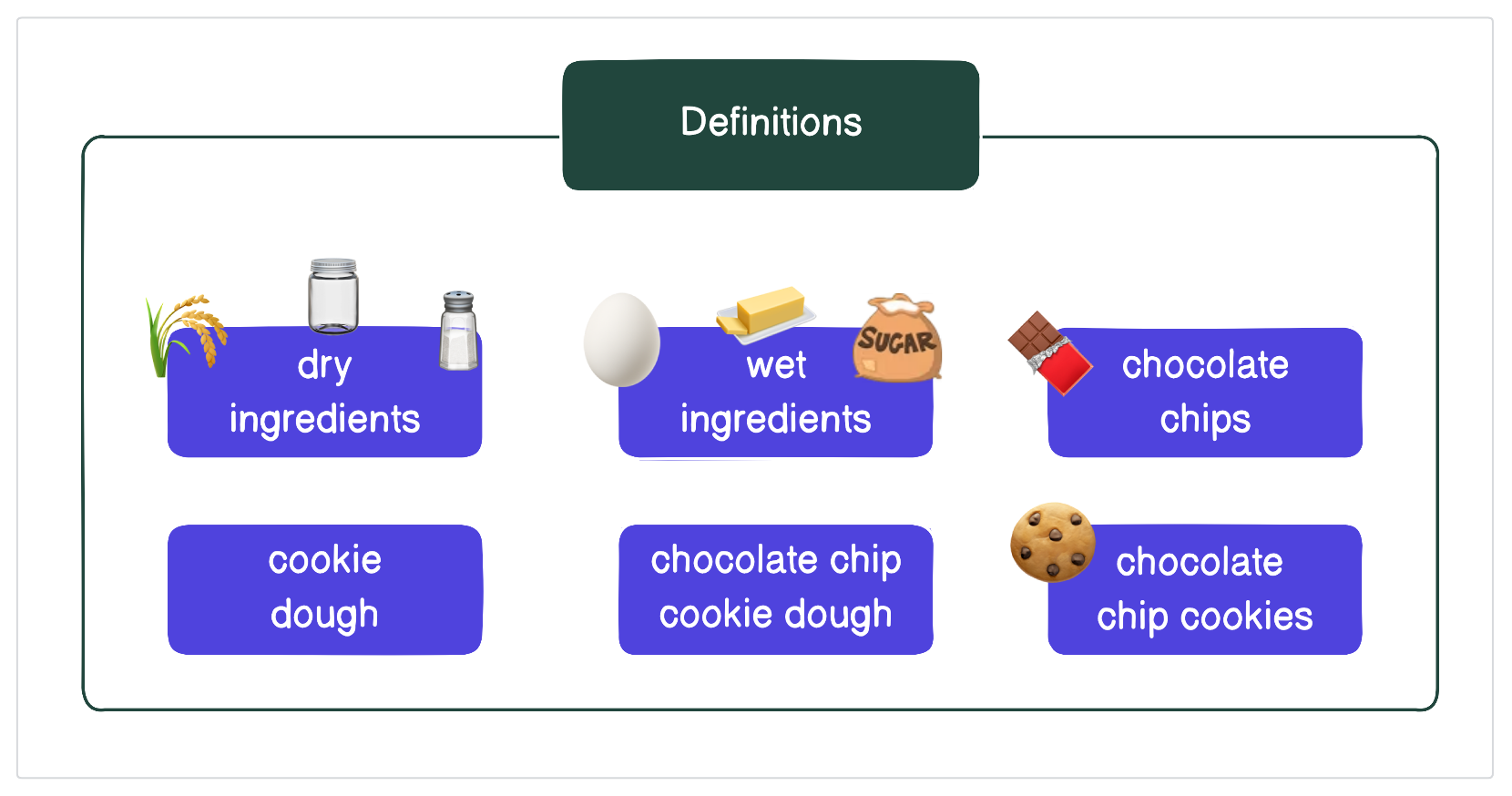What's the Definitions object?
Whenever you define an asset, resource, or schedule in your Dagster deployment, it needs to be part of a Definitions object for the code location you’re working in. Each code location can only have a single Definitions object. This object maps to one code location. With code locations, users isolate multiple Dagster projects from each other without requiring multiple deployments. You’ll learn more about code locations a bit later in this lesson.
Let’s use our cookie example to demonstrate. In this case, our cookie assets - like our dry and wet ingredients, cookie dough, chocolate chip cookie dough, and eventually, chocolate chip cookies - can all be thought of as (cookie) definitions:

In Dagster, the Definitions object is located in the definitions.py file. If we wanted to create a Definitions object for the cookie definitions we have so far, it would look something like this:
defs = Definitions(
assets=[
dry_ingredients,
wet_ingredients,
chocolate_chips,
cookie_dough,
chocolate_chip_cookie_dough,
chocolate_chip_cookies,
]
)
Note that assets aren’t the only type of definition in Dagster: there are also others like resources, schedules, and sensors. We’ll go into detail on each of these in later lessons, but for now, keep this in mind.
You’ll only have one code location (and therefore one Definitions object) in this course, but as your project grows, you’ll need to update the Definitions object to include new definitions.
How Dagster uses the Definitions object
Now that we’ve discussed what the Definitions object is, let’s go into how Dagster uses it.
When running dagster dev, Dagster looks to the pyproject.toml file. This file contains all of the Python dependencies necessary to run Dagster as well as Dagster specific settings on where the Definitions object should be loaded.
[tool.dagster]
module_name = "dagster_essentials.definitions"
code_location_name = "dagster_essentials"
In your project, open the dagster_university/definitions.py file. It should look like the following code:
import dagster as dg
from dagster_essentials.assets import trips, metrics
trip_assets = dg.load_assets_from_modules([trips])
metric_assets = dg.load_assets_from_modules([metrics])
defs = dg.Definitions(
assets=[*trip_assets, *metric_assets]
)
Anatomy of the definitions.py file
Let’s break down this file’s code line-by-line.
The following line introduces the Definitions object we were talking about. It also imports a method called load_assets_from_modules, which we’ll use to tell Dagster to retrieve the assets you defined:
import dagster as dg
Following Dagster’s recommended file structure, assets should be stored in a separate Python module. In this example, we used Python’s relative import functionality to import the trips and metrics sub-modules from the .assets module:
from dagster_essentials.assets import trips, metrics
These lines use the load_assets_from_modules function to store the assets into variables called trip_assets and metric_assets:
trip_assets = dg.load_assets_from_modules([trips])
metric_assets = dg.load_assets_from_modules([metrics])
When loading a code location, Dagster looks for a variable that contains a Definitions object. This is the most important section of the definitions.py file. Here, everything is combined and added into the Definitions object.
The Definitions object takes multiple arguments, one for each of the possible Dagster definitions (ex., assets, resources, schedules). In this case, we passed in the assets we loaded into the assets argument:
defs = dg.Definitions(
assets=[*trip_assets, *metric_assets],
)